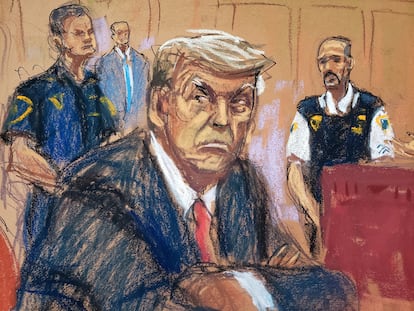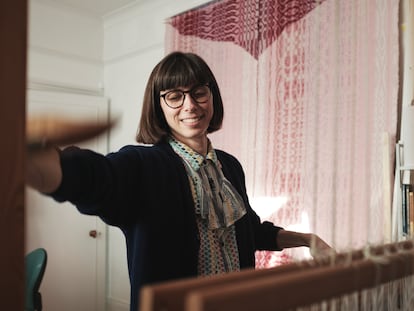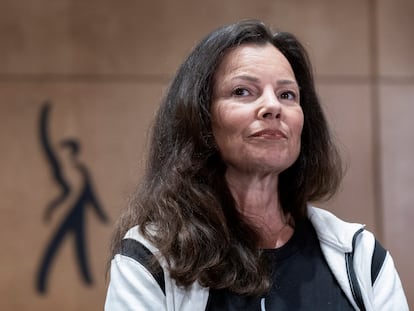Jane Rosenberg: A courtroom sketch artist and the creator of a historic ‘New Yorker’ magazine cover
Since she began her career in the 1980s, she has illustrated the trials of Mark David Chapman, R. Kelly, Donald Trump and others

In 1935, the trial for the so-called “crime of the century” was taking place in the United States. Bruno Hauptmann was accused of having kidnapped and murdered the son of the famous pilot Charles Lindbergh. The case was recorded by over 120 cameras inside the courtroom. At the time, Lindbergh — already an American hero for being the first to fly from New York to Paris in his plane in 1927 — had the country’s sympathies for a much more heartbreaking reason: the remains of his 20-month-old baby had been found in a forest near his New Jersey home, after the pilot had paid a $50,000 ransom. No one questioned the verdict that found Hauptmann guilty, but he appealed it on the grounds that the surrounding media circus had denied him the right to a fair trial. His appeal was unsuccessful, but it prompted the American Bar Association to prohibit camera access to courtrooms. That has been a controversial rule ever since, and the ban has been unevenly applied in different states across the country. The prohibition of cameras has also been discussed repeatedly in media-circus cases such as O. J. Simpson’s trial and, more recently, Gwyneth Paltrow’s lawsuit. New York, however, never repealed the ban; beyond the question of whether it is more or less relevant in this era of global media frenzies, that means that people like Jane Rosenberg have one of the most peculiar — and perhaps anachronistic — jobs in the world: courtroom sketch artist.
In a Zoom conversation from her Manhattan home, Rosenberg explains that since she started working as a courtroom sketch artist in 1980, people have said that her job would disappear. Despite the ubiquity of photography and video, or perhaps because of it, the New Yorker (who doesn’t have any social media accounts) is experiencing a small but extraordinary moment of viral fame. The reason is her portrait of Donald Trump at his April 4 arraignment earlier this year. After the media explosion, her sketch became the first of its kind to grace the cover of The New Yorker. “I did two sketches that day. [In] the first one, [Donald Trump] was just sitting there with no real expression. And then the next time I sketched him, he had just pled not guilty. So, I thought, oh, I have to capture that: him speaking into the microphone. But when I got [to] my paper, he had turned around and glared at the prosecutor. And I was seeing him with that expression. So, I thought, oh, I have to get that,” she explains.

In 1981, when Rosenberg was first starting her career, she drew John Lennon’s killer. “The first big case I remember was when Mark David Chapman shot John Lennon… And I remember going to court, [looking at his] lawyer, and [I] thought, how could this lawyer represent this guy? And now I’m married to a defense attorney, and I understand how the system works, that everybody’s entitled to a defense.” Then, in 1993, she covered Woody Allen and Mia Farrow’s child custody trial. “It was long before MeToo. He was not found guilty of sex abuse at that trial. That was about custody, who is a better parent to raise these children… And he didn’t know any of the kids’ playdates, didn’t know any of their doctors. So, he did lose custody. He did not win the custody battle,” she recalls matter-of-factly. She explains that she works to reflect the reality of what occurs in court. “My job is to show exactly [what] is happening. My opinion has nothing to do with my sketching. If somebody is crying or somebody is laughing, if they’re jumping out of their seat, I have to capture that moment, whatever it is; it’s part journalism. That’s my job,” she declares.
Another of her viral sketches is from Ghislaine Maxwell’s 2021 trial. Maxwell, Jeffrey Epstein’s right-hand woman in his child trafficking scheme, took to drawing Rosenberg herself, and Rosenberg drew a meta-sketch. She says that it wasn’t the first time: it also happened with Eddie Murphy, who drew her drawing him. She also recalls the spectacular security at the 2019 case against Mexican drug trafficker Joaquín El Chapo Guzmán, which caused her to get stuck in a cab before even crossing the Brooklyn Bridge. On the more negative reactions to some of her portraits — such as when Tom Brady’s fans protested how ungracefully she had depicted him — Rosenberg observes that “celebrities are a little harder to draw. You really have to nail their likeness because everybody thinks they know what they look like from the movies, but they’re in different lighting in a courtroom. They’re sitting there in fluorescent lighting with no makeup or whatever,” she says.
Rosenberg came to this unusual profession after she realized that doing $1 portraits in tourist areas on Cape Cod, Massachusetts, was no way to make a living. “After college, I was a struggling artist. I was doing whatever I could to make a buck and earn a living. It was really hard. And then I saw a lecture by another courtroom artist at the Society of Illustrators… I never thought of being in a courtroom. When I saw this lecture, I thought, oh, that looks like something I’d love to do, but I don’t know if I’m good enough. And then I had friends who are lawyers who took me to court [and] I asked them a million questions like, where did the artist sit? What do they bring? [They] said, come next week; we’ll let you sit with the media. So, I went [and] I sat in the jury box. There were two other artists. I did my sketch, and I thought, I really should try [it]. NBC ended up using [my sketch], shooting it on film. And I came home and watched it on my little black-and-white TV in my living room. And I called my parents,” she recalls.
In 43 years of courtroom sketch-journalism, Rosenberg has borne witness to the evolution of two pillars of democracy: the media and justice. She is more optimistic about the latter than the former. “It seems like there are themes. In my decades of courtroom art [over] 43 years, there’s been mafia cases for a long time. There were a lot of terrorist cases. For a long time, there was business, [Bernie] Madoff and all that. And now there seems to be a MeToo theme. It seems a lot of cases I’m doing are MeToo. There’s always been police brutality cases from the very beginning until today. And there were no cell phones when I first started. So, the first police brutality case, there was no video like [in] the George Floyd [case]. And I think [jurors] have always gotten it right,” she says. “I don’t feel that there’s been an evolution of the justice system. I feel possibly there’s been an evolution of the media, which is who I work for. When I first started, there were only three major television stations, and the news was only at six and seven. And then it was [on] at five, six and seven. Then [there] was a noon show. So, my deadlines kept getting faster. [Now, it’s] 24/7. So now I’ve got to get my sketches right out there as soon as I can. They’re waiting for me now. Get it out now. So that’s what’s evolved,” says Rosenberg. At the height of the Covid-19 pandemic, the sketch artist also had to do her portraits by videoconference (for example, she did sketches for the trials of the Capitol rioters) and even continued to do portraits of defendants and witnesses wearing their face masks.
Days before our conversation, Rosenberg had just watched the arraignment of Daniel Penny, the Marine who killed a young African American man on the New York subway. She mentions the difficulties she endured in the case of journalist E. Jean Carroll — who accused Donald Trump of raping her — as a result of the number of computers and screens blocking her view of the plaintiff. Is it stressful? “It’s more nerve-racking to start on day one in the case. I never know what I’m going to face. I don’t know where I’m going to sit. If I’ll get to see that, I could see anything once I have more of an understanding of what the way a trial is going to be and where I’ll end up. Not saying I’m not going to be nervous every day. There’s always a challenge, every single day, a new challenge. Trials are different from arraignments or hearings. They’re so quick... But a trial takes up almost a year for something to actually begin,” she explains.
But she softens when she takes stock of what her career means to her: “I love my job. I feel like I’m doing a public service. And even though I don’t have a lot of time for my personal life, it’s still fascinating for me to watch a trial. I feel like almost every day I’m sitting in front of a show in some way.” However, returning to the initial point, she argues that, with or without her, the show must be protected from show business. “I think the courtroom is a sacred place. I don’t think it should be made into entertainment. I think a lot of people are a little intimidated to be on camera. Witnesses might be a little intimidated. Lawyers might play to the cameras. There’s a lot of power in an editing room [over] what’s put on the television.”
Sign up for our weekly newsletter to get more English-language news coverage from EL PAÍS USA Edition
Tu suscripción se está usando en otro dispositivo
¿Quieres añadir otro usuario a tu suscripción?
Si continúas leyendo en este dispositivo, no se podrá leer en el otro.
FlechaTu suscripción se está usando en otro dispositivo y solo puedes acceder a EL PAÍS desde un dispositivo a la vez.
Si quieres compartir tu cuenta, cambia tu suscripción a la modalidad Premium, así podrás añadir otro usuario. Cada uno accederá con su propia cuenta de email, lo que os permitirá personalizar vuestra experiencia en EL PAÍS.
¿Tienes una suscripción de empresa? Accede aquí para contratar más cuentas.
En el caso de no saber quién está usando tu cuenta, te recomendamos cambiar tu contraseña aquí.
Si decides continuar compartiendo tu cuenta, este mensaje se mostrará en tu dispositivo y en el de la otra persona que está usando tu cuenta de forma indefinida, afectando a tu experiencia de lectura. Puedes consultar aquí los términos y condiciones de la suscripción digital.
More information
Archived In
Últimas noticias
Alain Aspect, Nobel laureate in physics: ‘Einstein was so smart that he would have had to recognize quantum entanglement’
Imelda Castro, the woman who wants to rule the cartel battleground of Sinaloa
The new victims of the Republican war on Obamacare: Millions hit by soaring health insurance premiums
A country divided on migrant rights: Some US states expand protections while others restrict them
Most viewed
- David King, chemist: ‘There are scientists studying how to cool the planet; nobody should stop these experiments from happening’
- Reinhard Genzel, Nobel laureate in physics: ‘One-minute videos will never give you the truth’
- Oona Chaplin: ‘I told James Cameron that I was living in a treehouse and starting a permaculture project with a friend’
- Sinaloa Cartel war is taking its toll on Los Chapitos
- Mexico completes its trade shift with the entry into force of tariffs on China and countries without trade agreements










































